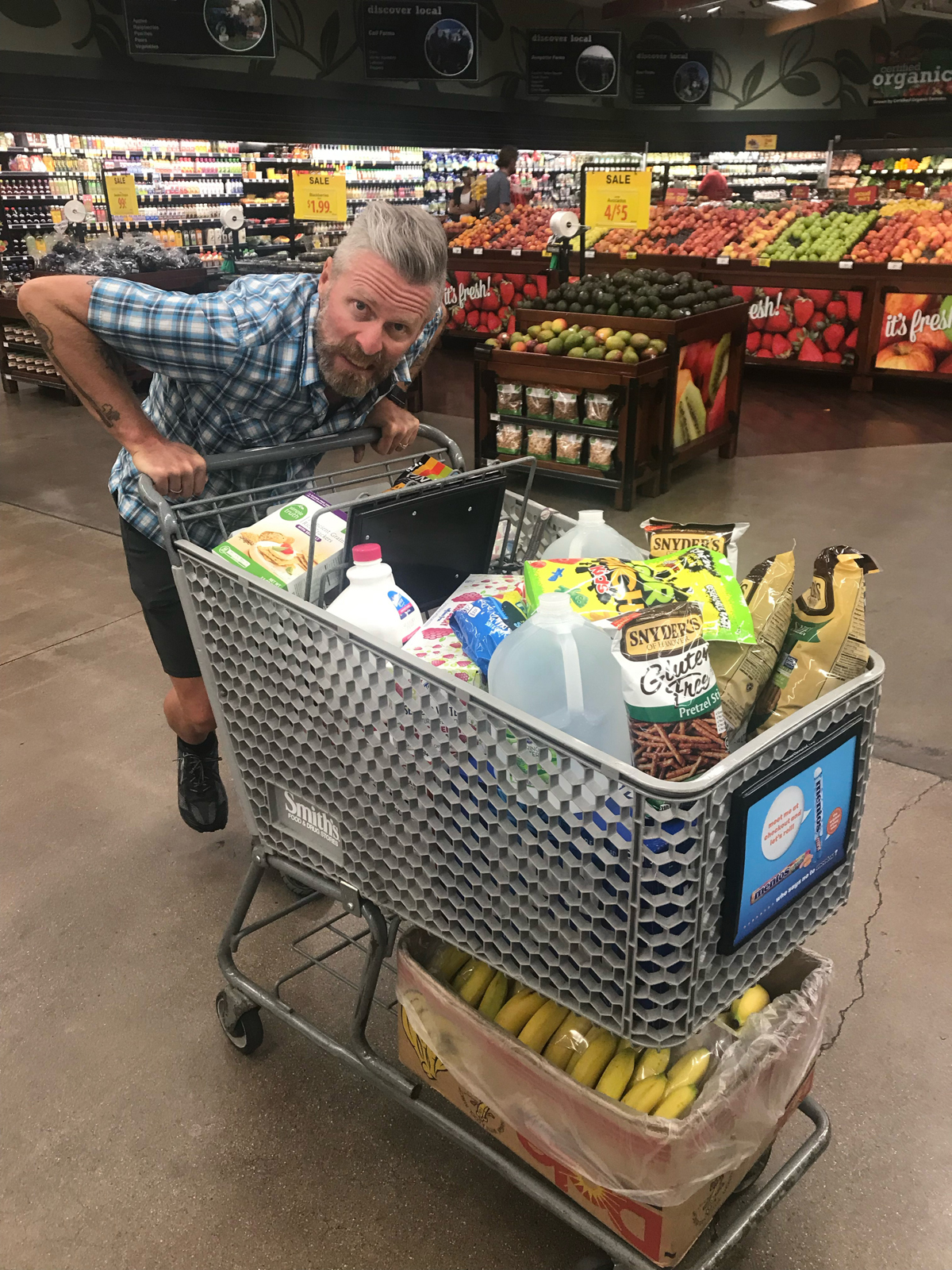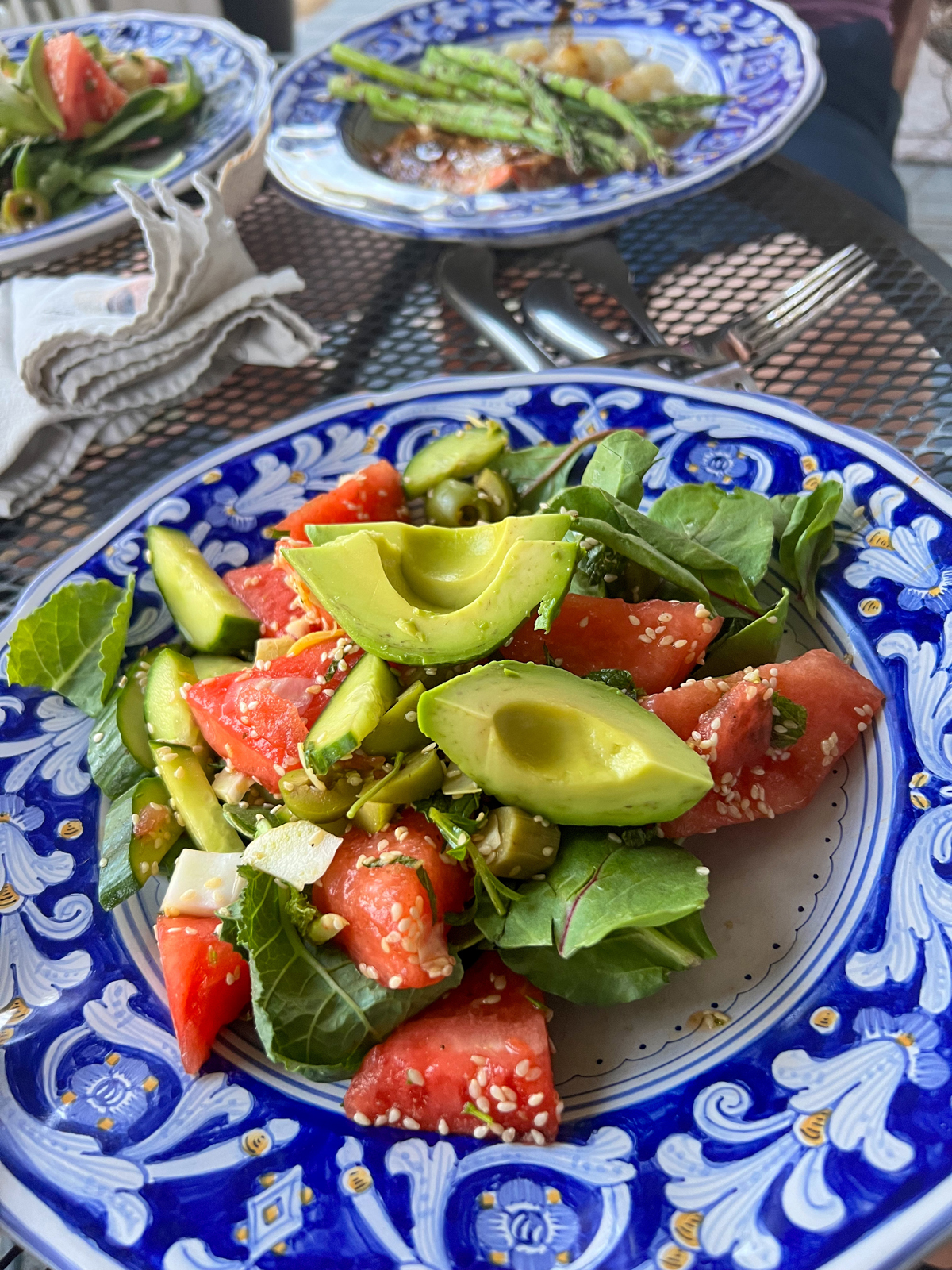Let’s face it, the current status of our world is forcing us to cook at home every day. This is not a bad thing! Most of us normally have the goal of eating out less and eating more healthily at home, so no better time than now. As cyclists/athletes, we actually have more time to train and therefore more opportunity to fuel our bodies properly.
But do you know what to get at the store to keep your fridge and pantry stocked with the right goodies?

No matter how you shop — in the store or online — the basics of healthful eating remain the same. Use the tips below to maximize your purchases so that your cooking can trim fat, sodium, and added sugars while increasing flavor and nutrient content. Here we go!
At the supermarket, shop for healthful ingredients based on foods from the 5 food groups: fruits, vegetables, whole grains, lean proteins, and low-fat or fat-free dairy foods. Use the tips below to maximize nutrition and trim saturated fat, sodium, and added sugars in the aisles. The main tip to start is shop in color, and shop the perimeter of the grocery store first so you fill your cart with fresh foods before hitting the aisles and being tempted by processed foods.
Fruits and Vegetables
- Choose multiple colors of fresh produce to get a variety of nutrients.
- Tip: Produce is perishable, so don’t buy more than you need for the week.
- Tip: When buying fresh produce, fruits and vegetables that are in season tend to sell at lower prices.
- Pick up time savers such as prewashed lettuce and greens and precut fruits and vegetables.
- Stock up on frozen, canned, jarred, and dried options. Choose plain frozen vegetables and reduced-sodium or no-added-salt versions of canned vegetables. Look for unsweetened canned and jarred fruits, or types packed in their own juice or water. Choose dried fruits without added sugars.
Grain-Based Foods
- Choose mostly whole-grain versions of foods like bread, cereal, rice, and pasta. Examples are 100% whole-wheat bread, oatmeal, shredded wheat, brown rice, and whole-wheat spaghetti.
- Enjoy “ancient grains” like quinoa, amaranth, and millet. These examples are whole grains, too.
- Tip: Save time with quick-cook grains like quinoa or rice
Dairy (or not!)
- Select low-fat and fat-free versions of milk, yogurt, and cheese. Or better yet, the plant-based milk alternatives will eliminate cholesterol entirely.
- Compare added sugar on labels and choose those with lower amounts or the label “unsweetened.”
- Almond, oat, cashew, soy, coconut, etc. milk alternatives are all great choices Change it up and try different milks with your smoothies, cereals, even baked goods!
Protein Foods
- Choose lean meats — look for cuts with “loin” or “round” in the name to minimize saturated fat.
- Buy skinless poultry or remove the skin before or after cooking.
- Choose fatty fish such salmon, Atlantic or Pacific mackerel, tuna, and sardines for their heart-healthy omega-3 fatty acids. Find them fresh, frozen, canned, or in pouches. Opt for “wild caught” brands.
- Try plant proteins like nuts and seeds, peanut butter, almond butter, beans (kidney, black, pinto, garbanzo, and more), peas and lentils.
- Buy economical bags of dry beans to make from scratch. For convenience, stock up on reduced-sodium canned beans, or rinse regular beans under cold water to reduce sodium.
- Experiment with soy proteins like edamame (green soybeans), tofu (soybean cake), and tempeh (fermented soybean cake that may also contain grains).
Oils and Spreads
- For cooking and baking, choose a liquid vegetable oil like olive, canola, corn, cottonseed safflower, soybean, or sunflower oil. Oils contain less saturated fat than solid fats like butter and lard.
- For spreads, buy soft tub, liquid, or spray margarines for less saturated fat than butter or stick margarine. Look for products with no trans fat by checking the Nutrition Facts label and in the ingredients for words like “partially hydrogenated.”
Strategic Shopping Tips
- Staying organized is a key to saving time and money when you grocery shop. Try these tips:
- Create a “master” list of frequently purchased items. That way, you can quickly check off what you need on your next shopping trip.
- Don’t overbuy. Check your fridge, freezer, and pantry for items already on hand.
- Make a shopping list. Put it on paper or use a meal-planning app on your smartphone that generates a shopping list based on your chosen recipes and other items you add. Many supermarkets offer apps that let you make lists and clip electronic coupons.
- Be efficient at the store. Organize your list according to your store’s layout to avoid backtracking. Stick with the items on your list to avoid costly “impulse” purchases. Shop at less busy times, usually early in the morning or later in the evening.
- Shop smart online. Review your past orders (usually available under your account information) to jog your memory for items you need. Stick to your list and resist the impulse to add unneeded items to your online cart.
When your pantry is well stocked, a nutritious and tasty meal or snack is just minutes away. Get suggestions for what to stock and learn about 10 popular pantry staples below.
The Scoop on 10 Popular Pantry Staples
- Oats. Oats provide iron and B vitamins, and contain soluble fiber, which may help lower blood cholesterol. Oatmeal makes a satisfying breakfast, but also enjoy oats in smoothies, cookies, pancakes, and homemade granola and snack bars.
- Whole-grain ready-to-eat cereals. Choose a cereal that lists a whole grain as the first ingredient. Compare the Nutrition Facts label on different brands to find options with at least 3 grams of dietary fiber and the fewest grams of added sugars per serving. Enjoy whole-grain cereal for a quick breakfast or snack or add to homemade trail mix.
- Whole grains. Nutty-tasting brown rice is a whole-grain food that offers dietary fiber, protein, and B vitamins. Use it as a side dish and in salads, soups, and stuffing. Use other whole grains, such as quinoa, millet, and amaranth, in most recipes that call for rice.
- Whole-grain pasta. Look for options made from whole wheat, brown rice, quinoa, or other whole grains. Whole-grain pasta is usually higher in dietary fiber and protein than enriched pasta. Stock a variety of shapes to use as an entrée with your favorite sauce, or as an ingredient in soups, casseroles, and cold salads.
- Beans and lentils. Dried and canned beans and lentils provide dietary fiber, protein, and B vitamins. Stock a variety such as black, pinto, kidney, and white beans, and brown, green, and red lentils. Add them to salads, soups, chili, salsa, casseroles, and pasta.
- Tuna, salmon, and sardines (cans or pouches). Packed with protein and heart-healthy omega-3 fats, use tuna, salmon, and sardines in salads, sandwich fillings, and casseroles, or for a snack on crackers.
- Canned tomatoes. Tasty canned tomatoes add vitamin C and the antioxidant lycopene to a variety of dishes. Use whole or crushed tomatoes for sauces and soups. Choose diced tomatoes for bruschetta, salsa, or guacamole.
- Stocks and broths (unsalted or low sodium). Stocks and broths add flavor to soups, stir-fries, sauces, stuffings, rice, pasta, and more.
- Mustard. Mustard, such as Dijon or spicy brown mustard, adds creaminess and zesty flavor to salad dressings, sauces, marinades, and dips. It’s also great in chicken, beef, pork, and seafood dishes.
- Cooking oils. Keep a variety of oils for different purposes. For instance, use a fruity olive oil in salad dressings and neutral-flavored canola oil in baked goods. Drizzle toasted sesame oil onto stir-fried vegetables.
Stocking a Healthy Pantry
Check out the list of suggested pantry stables below and add your own favorites. Read labels to see if items should be refrigerated after opening.
- Beans, peas, and lentils (dry or reduced-sodium canned)
- Peanut butter, nut butters
- Pasta sauce (reduced sodium)
- Cans or pouches of seafood (such as tuna, salmon, and sardines)
- Canned fruit (water or packed in 100% juice)
- Canned vegetables (reduced sodium or no added salt)
- Canned soup (reduced sodium)
- Canned tomato products (such as whole, diced, and crushed; reduced sodium or no added salt)
- Jars of roasted red peppers, artichoke hearts, and olives
- Dried fruit (without added sugar)
- Whole-grain, hot, and ready-to-eat cereals (such as oatmeal, shredded wheat, and whole-wheat flakes)
- Whole grains (such as brown rice, barley, bulgur, farro, quinoa, buckwheat, amaranth, millet, and sorghum)
- Whole-grain pasta (such as spaghetti, rigatoni, and shells)
- Whole-grain crackers
- Popcorn (kernels or “light” microwave)
Take the next step and make your grocery list based on a meal plan specific to your needs and goals. For help determining your macro- and micro- nutrient needs, contact me to schedule an appointment.
Breanne Nalder Harward, MS, RDN, earned a BS in Biology and Sociology from Westminster College and went on to receive a Master of Science degree in Nutrition and Sports Dietetics from the University of Utah. She is licensed as a Registered Dietitian Nutritionist (RDN) and is the nutrition coach at PLAN7 Endurance Coaching and Utah Sports and Wellness. You can find more info on her at plan7coaching.com and utahsportsandwellness.com or follow her on social media @breezysaycheezy.








